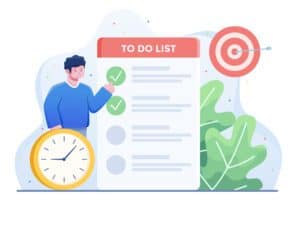 Employee productivity is a real problem in the United States, accounting for billions of dollars in lost revenue each year. To put into perspective just how big of a problem productivity — or lack of it — is in U.S. workplaces, several studies have been done to measure it in terms of time and money. Below are a few eye-opening statistics worth considering:
Employee productivity is a real problem in the United States, accounting for billions of dollars in lost revenue each year. To put into perspective just how big of a problem productivity — or lack of it — is in U.S. workplaces, several studies have been done to measure it in terms of time and money. Below are a few eye-opening statistics worth considering:
- The average employee experiences interruptions every three minutes. It takes approximately 23 minutes for a person to refocus, meaning that the average employee gets three minutes of work done every 26 minutes.
- The average office worker is productive for just two hours and 23 minutes every day.
- Meetings are the biggest time waste of all, as a whopping 91% of attendees admit to daydreaming in meetings. More surprising is the fact that 39% of workers admit to having fallen asleep in a meeting before.
- Social media consumes a big part of people’s days, with most employees spending nearly 32% of their workdays on apps.
If you’re alarmed by these statistics, you are not alone. Lack of efficiency affects every workplace from small businesses to large corporations and across all industries. If you don’t take steps to mitigate it, you may unwittingly be costing your company thousands to millions of dollars each year. The good news is that steps do exist to combat the loss of workplace productivity. Better yet, hundreds of innovative tools exist that can help employees manage their time better and get more work done in fewer hours. You can explore the most effective tools here.
Workplace Efficiency: What Does It Really Mean?
Before you familiarize yourself with all the different productivity tools designed to boost workplace performance, it’s important that you can distinguish between productivity and efficiency. Efficiency refers to how well your business utilizes its available resources, including employee time, to achieve a desired outcome. Efficiency encompasses employee engagement, employee productivity, and office space utilization, among other areas. While efficiency measures the amount of output you generate from a given input, productivity measures how much your team gets done in a given period of time.
Why Does Workplace Efficiency Matter?
Aside from the obvious — which is that unproductive workers cost you money — workplace productivity management matters for several reasons. Below are a few areas of your business in which you might see noticeable improvements as you boost the efficacy of your team.
Customer Satisfaction
If you’ve ever been the target of rude customer service, then you understand just how intricate the link is between employee satisfaction and customer satisfaction. Dissatisfied employees — or downright lazy ones — give paying customers a bad impression of your brand. That impression often lingers with customers, who will remember your company for little more than the lackluster service. On the other hand, increased employee satisfaction translates to increased productivity. More productivity means your brand can provide more value to your customers, and more value leads to increased customer satisfaction and loyalty. 
Increased Productivity
More efficient workplaces are also more productive workplaces. Efficient workplaces are those that discourage multi-tasking (which reduces productivity by as much as 40%), minimize distractions (such as email, meetings, and phone calls), allow employees to work alone and/or from home, and encourage employee engagement (as engaged employees are 21% more productive than non-engaged employees). Additionally, efficient workplaces are those that make use of digital tools, as 46% of workers say digital tools make them feel more productive.
Reduced Operating Costs
Inefficiency costs U.S. businesses anywhere from $450 to $550 billion annually. These figures come in the form of lost productivity, absenteeism, more accidents, more errors and low customer satisfaction, among other areas.
Lower Rates of Error
In workplaces in which workers are disengaged, the rate of error is as high as 60%, while the accident rate is nearly 50%. Errors and accidents are two of the main contributors of lost business revenue each year. You can reduce error and accident rates significantly by maintaining an efficient workplace in which workers are engaged.
An Ideal Productivity Baseline
Before you explore all the different productivity tools that can increase efficiency in your workplace, it’s a good idea to establish a baseline. What percentage of productivity should you aim for? Every office environment is different, and the ideal level of productivity depends largely on the type of work your employees do and the strenuousness of assignments. However, a good baseline for most companies is a productivity percentage of between 70% and 75%. This means that your employees spend between 70% to 75% of their time in the office working and the remaining 25% to 30% on breaks or “me-time.” The breaks are necessary, as they can help prevent burnout and contribute to a better work-life balance.’ 
Tips for Increasing Employee Productivity
If your workforce is typical, your productivity levels are right around 30%. This means you have your work cut out for you to reach a baseline of at least 70%. In addition to implementing productivity software for workplace success, consider using the following tricks.
Strengthen Internal Communications
Lack of or miscommunication is a huge time waste and a major source of employee dissatisfaction. By streamlining internal communications, and by strengthening them, you can boost employee productivity by as much as 25%. Effective communication contributes to more cooperation within your organization and enables employees to dedicate their efforts to tasks and projects that matter as opposed to forcing them to concentrate on busy work.
Use Incentives
One ground-breaking study shows that incentive programs can boost employee engagement and performance by anywhere from 25% to 44%. Not only that, but incentive programs attract higher caliber workers and increase employee retention. Better workers mean more gets done in a given day, and reduced attrition rates mean you spend fewer resources on the hiring and training processes.
Be Liberal With Your Praise
Another study shows that kindness pays, literally. Research shows that when praised, the human brain releases a rush of dopamine, which triggers creating thinking and innovation in the workplace. Another survey of more than 10,000 businesses across 30+ industries found that employees who receive praise regularly throughout their day tend to engage more with their colleagues, do more during their workdays and have fewer on-the-job accidents. They also tend to receive higher satisfaction and loyalty scores from customers.
Give Team-Building a Try
Though it may seem hokey to you, team-building exercises create a more cohesive, cooperative, and efficient office environment. Team building also helps to build intrapersonal relationships between members of your team, which serves to motivate members to want to show up and, more importantly, do well.
Consider Everyone’s Strengths and Weaknesses
It’s hard for a person to be productive if he or she does work that is above, below or outside of his or her skill level. If you want to build and maintain the most effective team, assign roles according to workers’ strengths and weaknesses. Also, strive to assign roles based on interest. Though this may not always be possible, people tend to expend more effort on projects that excite them.
Make Constructive Feedback the Norm
Constructive feedback serves several purposes. The most obvious benefit of constructive feedback is that it gives employees advice and guidance off of which to base their decisions going forward. It also gives you peace of mind that they understand what steps you want them to take going forward and that they have received the feedback well. Additionally, constructive feedback lets you hear employees’ opinions, and it gives you the opportunity to develop any next steps together. Finally, and possibly most importantly, constructive feedback tells your team members that you care enough about them and their performance to schedule a one-on-one meeting with them.
Avoid Micromanaging
Micromanaging is possibly one of the worst things a manager can do in the workplace, as micromanaging has several adverse effects. Among others, micromanaging can lead to increased stress in the workplace, reduced productivity and low creativity. Moreover, employees who have micromanagers tend to have worse mental health than those who do not and experience burnout more quickly than their more independent counterparts. While every business owner is free to develop his or her own personal management style — as should you — one type of management style you want to avoid entirely is micromanagement. 
Top 10 Best Productivity Software for Increasing Workplace Efficiency
There are dozens of digital tools available to you that can enhance workflow and increase employee collaboration and efficiency. Below are a few of the internet’s top picks.
1. PDFSimpli
PDF is the most reliable type of document for trading sensitive, confidential, or important information. PDF is also portable (as the “P” in its name suggests), editable, and compatible with all servers. Finally, PDF is able to deliver quality products regardless of file size or image inclusion. Though PDF offers several benefits, you cannot edit or change the text for free. While you can convert PDF files to Word or other easily-editable formats, you risk losing formatting. Finally, though PDF is the most secure file type, it’s hard to add a signature because, well, editing issues. PDFSimpli removes all the hassle associated with PDFs. With PDFSimpli, you can seamlessly convert PDFs to any type of format your heart desires, and vice versa. With the software, you never risk losing your formatting. You can also add editable signature fields for free. PDFSimpli is compatible with Microsoft OneDrive, Dropbox and Google Drive. It works on both Windows and Mac web browsers. You don’t need any technological know-how to use the software. You can test drive the software for one month for free. After that, you will pay $39.95 per month.
2. Evernote
If you allow employees to work from home, or if your employees regularly toggle between devices, look into Evernote, an all-in-one note-taking and productivity app. With Evernote, you and your employees can store your content in one place with peace of mind that you will be able to access it from any device of your choosing. The interface is simple to use and comes with powerful features, such as document scanning and app integration. You can try Evernote for free for 30 days, after which you can upgrade to a paid account for just $7.99 per month.
3. Time Doctor
While you should never micromanage your employees, you should give them a way to be accountable for themselves while on the clock. Time Doctor makes it easy for employees to track their own work habits by showing them just how much time they spend on what while at their workstations. The platform also allows individuals to set goals, identify trends, monitor work performance and measure results. With clear data before them, even the most unmotivated of your employees may find the motivation to do better. Time Doctor is somewhat pricey, starting at $70 per user per month. Plans go up to $200 per month. However, the company does give you a 14-day free trial, during which time you can decide if Time Doctor really is a cure to your productivity problem.
4. ProofHub
ProofHub is a project management software that keeps all the tools your team needs to succeed in one place. With this software, you can plan and organize projects in such a way that every member of your team can view in real-time. You can also invite members to collaborate or share their input, assign group or personal tasks, and set project deadlines to change with task dependencies. ProofHub also allows you to prioritize tasks, create roles, customize workflows and control who receives notifications and when. The ProofHub essentials package — meaning, the one that comes with all the aforementioned features —s tarts at $89 per month.
5. NoteLedge
NoteLedge is a platform geared toward creatives who must be able to share their ideas and collaborate in real-time and whenever the mood strikes. Thanks to NoteLedge, members of your creative team can draw up a sketch, put together a mood board or simply organize their trains of thought and then save it all in one place. They can then share what they’ve saved with individual members of the team or the whole team, or they can keep it for themselves. NoteLedge starts at $29.99 per month but can go as high as $59.99 per month. The brand bills annually.
6. Slack
If much of your team works outside of the office but you still want to maintain that same in-office comradery and communication, you need Slack. Slack is a platform that allows you to bring all your projects and conversations to one central, online location while your employees works from wherever their hearts desire. Slack offers archiving, real-time messaging and search functions. It also integrates with Zoom, Google Drive, Jira and other services. You can try any one of Slack’s plans for free. After the trial period, rates start at $6.67 per month.
7. Trello
Trello is a project management tool that makes it possible for your employees to visualize their to-dos and prioritize projects. Through intuitive cards that you can either assign or employees can select, you can detail task instructions and deadlines and reassign as need be. Employees can also move cards to the “completed” queue or converse with you (or others) directly via the cards thanks to “Tags.” Trello integrates seamlessly with Zoom, Microsoft Teams and Google Drive. You can try Trello out for free, after which you will pay $5, $10 or $17.50 per month.
8. Freedom
As indicative of the productivity statistics, interruptions are a leading cause of lost productivity in the workplace. While there is little employees (or yourself) can do about in-person interruptions, you can help mitigate digital ones, with the help of Freedom. Freedom is a concentration software that enables you to block access and notifications from certain websites or apps at certain times of the day — or, if you feel it’s necessary, for the entire workday. With no digital distractions (a-hem, Facebook), you can ensure your team members stay on task and productive the entire time they’re clocked in. You can use Freedom for free for a brief trial period. After that, you can access all its features and benefits for just $3.33 per year.
9. Kissflow
Kissflow is a digital workplace assistant that makes it easy for employees to organize their workday, manage projects and share updates. The platform is characterized by dynamic dashboards and easy-to-use reporting features that allow users to provide data to others in real-time. You can request a demo for free or pay between $9.90 to $19 per user per month.
10. Toggl
Toggl is a tool that, like Time Doctor, helps your employees hold themselves accountable by offering project planning, time-tracking and reporting features. With this platform, you can also create tasks, track billable hours and log time spent on certain tasks. Toggl offers a free trial period, after which the price jumps to $9 per user per month. Workplace efficiency is a problem in the U.S., but it doesn’t have to be a problem in your workplace. Adopt the tricks and tools above to increase productivity in your workplace. Apollo Technical: https://www.apollotechnical.com/employee-productivity-statistics/ Snap Surveys: https://www.snapsurveys.com/blog/satisfied-employees-leads-satisfied-customers/ Zippia: https://www.zippia.com/advice/productivity-statistics/ Soft Activity: https://www.softactivity.com/ideas/true-financial-cost-of-poor-productivity/#:~:text=According%20to%20a%20report%20by,billion%20annually%20to%20lost%20productivity. Entrepreneur: https://www.entrepreneur.com/article/367864 Incentive Research Foundation: https://theirf.org/research/incentives-motivation-and-workplace-performance-research-and-best-practices/147/ Final Touch: https://finaltouchschool.com/business/kindness-pays-boost-productivity-through-praise/#:~:text=Being%20praised%20triggers%20the%20release,creative%20problem%2Dsolving%20at%20work. TrackTime24: https://tracktime24.com/Blog/the-negative-effects-of-micromanagement#:~:text=Low%20productivity%2C%20heightened%20stress%2C%20and,that%20their%20team%20members%20do.







